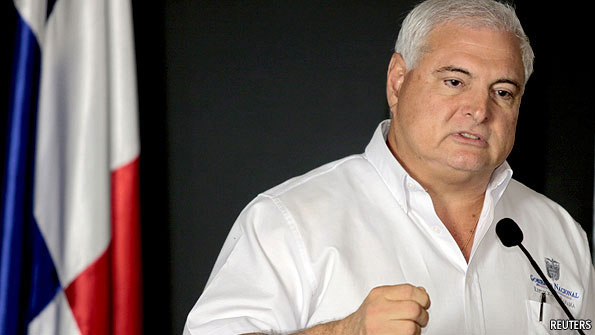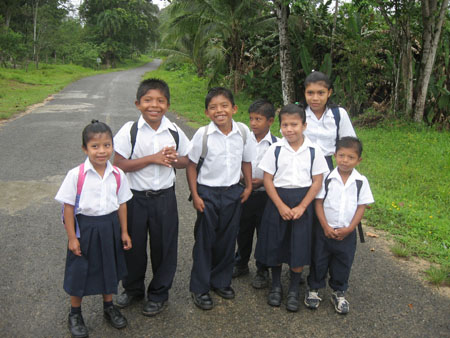Panamá’s Troubled Path Forward

Riding in from Tocumen International Airport to Panamá City after sunset, one comes upon the eastern edge of the city, the site of over a dozen looming high rises. Each stands nearly dark. Construction began over five years ago, but most remain empty, never occupied or completed. Ghost-like, they loom in the haze—a dead city. Their story is emblematic of the free market free-for-all in Panamá, which is producing both winners and some all too visible losers.
The aggregate numbers look great, with eye-popping GDP growth for several years running, hitting 8.5 percent last year, 10.6 percent in 2011, and 7.8 percent in 2010. The government of conservative pro-business President Ricardo Martinelli is cashing in on this growth, pouring money into big-ticket projects, including canal expansion and the building of a new metro system in Panamá City.
The most critical ongoing project is the construction of a new series of canal locks, wide and deep enough to accommodate almost all of today’s largest vessels. When the locks are finished next year the price tag will probably be considerably larger than the original $5.3 billion USD estimate. The work is a long overdue modernization of the 100-year-old canal. Still, critics, like veteran Panamanian newspaper reporter Eric Jackson, worry over reports that tall vessels will not be able to pass under the Bridge of the Americas or that the standby waiting zones for vessels are nowhere deep enough for the big ships that will be coming to use the new locks. Fixing these potential problems could prove very expensive, Jackson warns. [1]
Another government spending project is a brand new metro line in Panamá City. Once completed, the metro should provide relief for the traffic-clogged capital. Driving through the city is an adventure, with detours around myriad construction zones bringing traffic to a halt. Driving or even walking through Panamá City is not for the faint-hearted.

What troubles more Panamanians, however, are Martinelli’s priorities in government projects. One key concern is the availability of potable water. Following protests last year in the rural west of Panamá, mass demonstrations erupted this February in the Caribbean port of Colón, which has been without potable water for over a month. [2] Likewise, in Panamá City’s sprawling satellite city of San Miguelito, some residents have to rise at two in the morning to wait in line for water from the common spigots, Jackson reports.
Panamanian citizens are also concerned about with the country’s education system. The government offers a voucher program to families to help with school costs, uniforms, books, and supplies. Students wearing their uniforms enjoy the added advantage of reduced fares on public transit. However, the common experience with public schools is so consistently negative that the only families that send their children are the ones that have no other choice. Anyone with any means sends their children to private school. It is a two-tiered system: private schools with generally small classes, well-trained teachers, and state of the art computers for those with money, leaving the resource-starved public schools for everyone else. Public schools in Panamá cannot provide the educational training that would open up authentic chances for upward mobility. Therefore, as it stands, the educational system in Panamá assures a locked-in underclass.
Given these pressing social concerns, it is fair to ask if Panamá might be ready for a change in policy direction. But context is everything, and Panamá is predisposed to favor free enterprise. Its life blood is commercial banking, handling many legitimate deposits but also doing a lively business in money laundering. Also vital are the vast duty-free zones, and, of course, free-flowing transport by ship, rail or via pipelines.
Running hard against this sentiment is the widespread disgust with Martinelli’s galling corruption and his misplaced government spending priorities. Ordinary people voice a shared conviction that the government should focus on urgent pressing needs like access to water and improving public education.
Although under Panamá’s election laws Martinelli cannot be a candidate in next year’s election, chances for the left remain weak. It is not so much the strength of the right as the disarray of the left. The most likely candidate for the left, Juan Jované, a former advisor to the Nicaraguan Sandinistas, is uninspiring. A more attractive candidate is indigenous leader Silvia Carrera, but she is politically untested.
While no one could have predicted the rise of Venezuela’s Hugo Chávez, Ecuador’s Rafael Correa, or Bolivia’s Evo Morales, Panamá seem an unlikely Latin American candidate to move to the left. [3] Panamanians have not yet reached an anti-free market tipping point, but the failures of these policies are looming large.
Dr. Ronn Pineo, Senior Research Fellow at the Council on Hemispheric Affairs
Please accept this article as a free contribution from COHA, but if re-posting, please afford authorial and institutional attribution. Exclusive rights can be negotiated.
For additional news or analysis on Latin America, please go to: Latin News
References
1. Sumers, Brian, “Panama Canal expansion impact on ports discussed at California Senate panel session,” Daily News Los Angeles, February 22, 2013, http://www.dailynews.com/news/ci_22650472/Panamá-canal-expansion-impact-ports-discussed-at-california; Booth, William, “Expanded Panama Canal sparks race to be ready for bigger cargo ships,” The Washington Post, January 12, 2013, http://articles.washingtonpost.com/2013-01-12/world/36312072_1_cargo-ships-deep-harbor-port-terminals.
2. Sánchez, Oscar, “Protestas simultáneas por falta de agua en Colón” La Estrella, January 19, 2012, http://www.laestrella.com.pa/online/noticias/2012/01/19/protestas-simultaneas-por-falta-de-agua-en-colon.asp.
3. Jackson, Eric, “Police, politicians’ assaults fail to dislodge Silvia Carrera,” The Panama News, March 10, 2013, http://www.thepanamanews.com/pn/v_19/issue_02/news_special_04.html.

